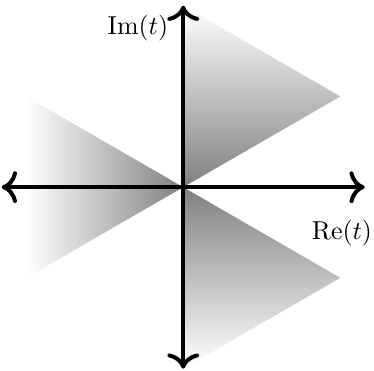Difference between revisions of "Airy Bi"
(→References) |
(→Properties) |
||
| Line 42: | Line 42: | ||
The variable of the integral defining $y$ is $t$ and for $t \in \mathbb{C}$ with $|t|$ very large, the cubic term in the exponent dominates. Hence consider polar form $t=|t|e^{i\theta}$ and compute | The variable of the integral defining $y$ is $t$ and for $t \in \mathbb{C}$ with $|t|$ very large, the cubic term in the exponent dominates. Hence consider polar form $t=|t|e^{i\theta}$ and compute | ||
$$e^{\frac{t^3}{3}} = \exp\left( \frac{|t|^3 e^{3i\theta}}{3} \right).$$ | $$e^{\frac{t^3}{3}} = \exp\left( \frac{|t|^3 e^{3i\theta}}{3} \right).$$ | ||
| − | Notice that the inequality $\mathrm{Re} \hspace{2pt} e^{3i\theta} \leq 0$ forces $\cos(3\theta)\leq 0$ yielding three sectors defined by $\theta$: | + | Notice that the inequality $\mathrm{Re} \hspace{2pt} e^{3i\theta} \leq 0$ forces $\cos(3\theta)\leq 0$ yielding three sectors defined by $\theta$: [[File:Airysectors.png|200px]] |
$$-\dfrac{\pi}{2} \leq \theta \leq -\dfrac{\pi}{6},$$ | $$-\dfrac{\pi}{2} \leq \theta \leq -\dfrac{\pi}{6},$$ | ||
$$\dfrac{\pi}{6} \leq \theta \leq \dfrac{\pi}{2},$$ | $$\dfrac{\pi}{6} \leq \theta \leq \dfrac{\pi}{2},$$ | ||
$$\dfrac{9\pi}{6} \leq \theta \leq \dfrac{11\pi}{6}.$$ | $$\dfrac{9\pi}{6} \leq \theta \leq \dfrac{11\pi}{6}.$$ | ||
| + | |||
Notice that the first two of these sectors includes the entire $y$-axis in the complex plane. Hence we will take our contour $\gamma$ to be the $y$ axis directed from $-i\infty$ toward $+i\infty$. This yields finally | Notice that the first two of these sectors includes the entire $y$-axis in the complex plane. Hence we will take our contour $\gamma$ to be the $y$ axis directed from $-i\infty$ toward $+i\infty$. This yields finally | ||
$$y(z)=\displaystyle\int_{-i\infty}^{i\infty} e^{zt+\frac{t^3}{3}} dt.$$ | $$y(z)=\displaystyle\int_{-i\infty}^{i\infty} e^{zt+\frac{t^3}{3}} dt.$$ | ||
Revision as of 08:50, 14 January 2015
The Airy function $\mathrm{Ai}$ and "Bairy" function $\mathrm{Bi}$ are given by the formulas $$\mathrm{Ai}(x) = \dfrac{1}{\pi} \displaystyle\int_0^{\infty} \cos \left( \dfrac{t^3}{3} + xt \right) dt$$ and $$\mathrm{Bi}(x) = \dfrac{1}{\pi} \displaystyle\int_0^{\infty} \left[ e^{-\frac{t^3}{3} + xt} + \sin \left( \dfrac{t^3}{3}+xt \right) \right] dt.$$
- Airyai.png
Airy $\mathrm{Ai}$ function.
- Airybi.png
Bairy $\mathrm{Bi}$ function.
Properties
Theorem: The function $\mathrm{Ai}$ is a solution to the differential equation $$y(z) - zy(z) = 0.$$
Proof: Suppose that $y$ has the form $$y(z) = \displaystyle\int_{\gamma} f(t)e^{zt} dt,$$ where $\gamma$ is an as-of-yet undefined contour in the complex plane. Assuming that we may differentiate under the integral it is clear that $$y(z)=\displaystyle\int_{\gamma} f(t)t^2 e^{zt} dt.$$ Thus we plug this representation into the differential equation to get $$(*) \hspace{35pt} y(z)-zy(z) = \displaystyle\int_{\gamma} (t^2-z)f(t)e^{zt} dt = 0.$$ Now we integrate by parts to see $$\begin{array}{ll} \displaystyle\int_{\gamma} zf(t)e^{zt} dt &= \displaystyle\int_{\gamma} f(t) \dfrac{d}{dt} e^{zt} dt \\ &= -f(t)e^{zt} \Bigg |_{\gamma} + \displaystyle\int_{\gamma} f'(t)e^{zt} dt. \end{array}$$ We will pick the contour $\gamma$ to enforce $f(t)e^{zt} \Bigg |_{\gamma}=0$. We will do this by first determining the function $f$. Plugging this back into the formula $(*)$ yields $$\begin{array}{ll} 0 &= y(z) - zy(z) \\ &= f(t)e^{zt} \Bigg |_{\gamma} + \displaystyle\int_{\gamma} (t^2f(t)-f'(t))e^{zt} dt. \end{array}$$ We have the freedom to choose $f$ and $\gamma$. We will choose $f$ so that $$t^2f(t)-f'(t)=0.$$ This is a simple differential equation whose solution is $$f(t)=c e^{\frac{t^3}{3}}.$$ So we have derived $$y(z)=\displaystyle\int_{\gamma} e^{zt + \frac{t^3}{3}} dt.$$ To pick the contour $\gamma$ note that the integrand of $y$ is an entire function and hence if $\gamma$ is a simple closed curve we would have $y(z)=0$ for all $z \in \mathbb{C}$.
The variable of the integral defining $y$ is $t$ and for $t \in \mathbb{C}$ with $|t|$ very large, the cubic term in the exponent dominates. Hence consider polar form $t=|t|e^{i\theta}$ and compute
$$e^{\frac{t^3}{3}} = \exp\left( \frac{|t|^3 e^{3i\theta}}{3} \right).$$
Notice that the inequality $\mathrm{Re} \hspace{2pt} e^{3i\theta} \leq 0$ forces $\cos(3\theta)\leq 0$ yielding three sectors defined by $\theta$:  $$-\dfrac{\pi}{2} \leq \theta \leq -\dfrac{\pi}{6},$$
$$\dfrac{\pi}{6} \leq \theta \leq \dfrac{\pi}{2},$$
$$\dfrac{9\pi}{6} \leq \theta \leq \dfrac{11\pi}{6}.$$
$$-\dfrac{\pi}{2} \leq \theta \leq -\dfrac{\pi}{6},$$
$$\dfrac{\pi}{6} \leq \theta \leq \dfrac{\pi}{2},$$
$$\dfrac{9\pi}{6} \leq \theta \leq \dfrac{11\pi}{6}.$$
Notice that the first two of these sectors includes the entire $y$-axis in the complex plane. Hence we will take our contour $\gamma$ to be the $y$ axis directed from $-i\infty$ toward $+i\infty$. This yields finally $$y(z)=\displaystyle\int_{-i\infty}^{i\infty} e^{zt+\frac{t^3}{3}} dt.$$